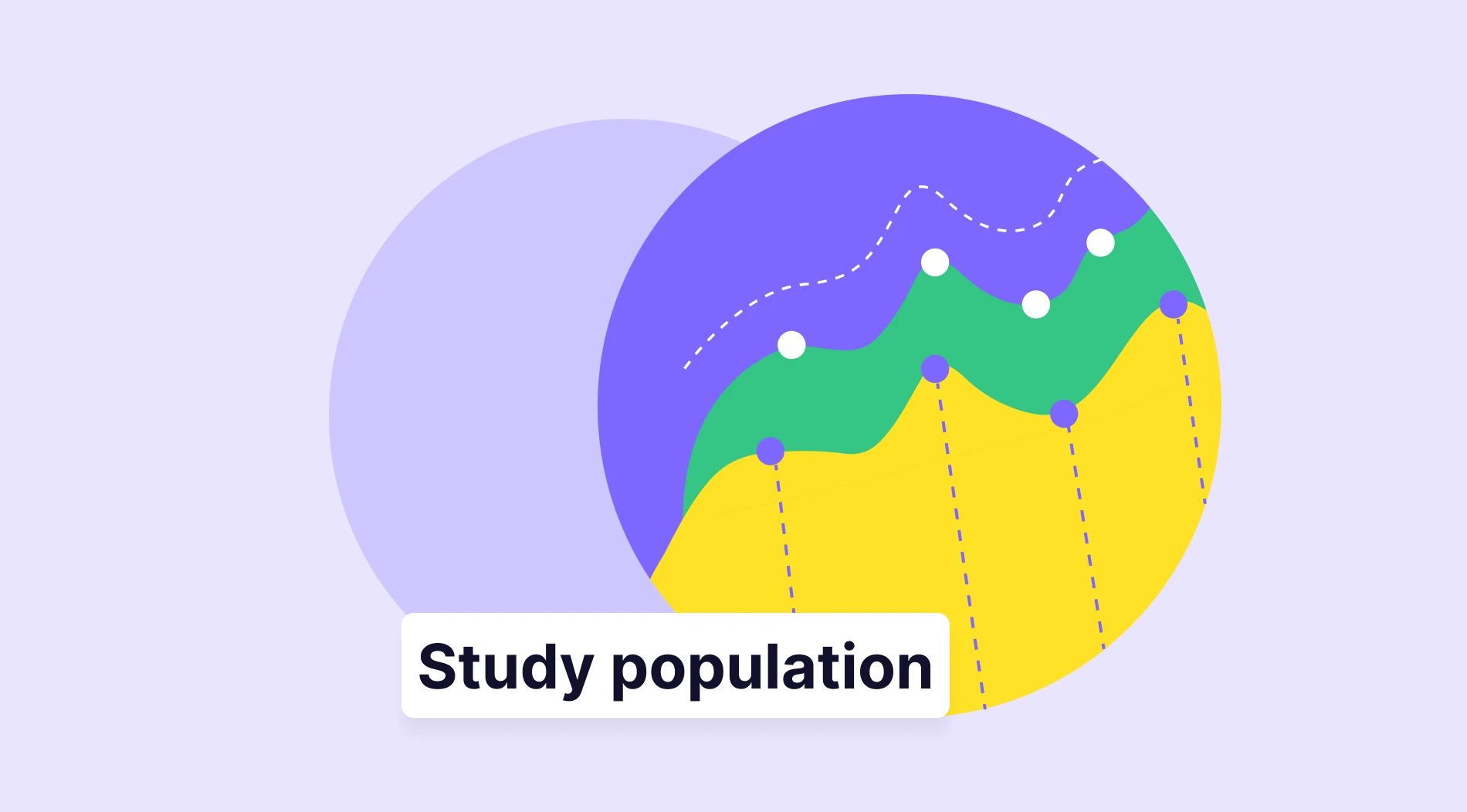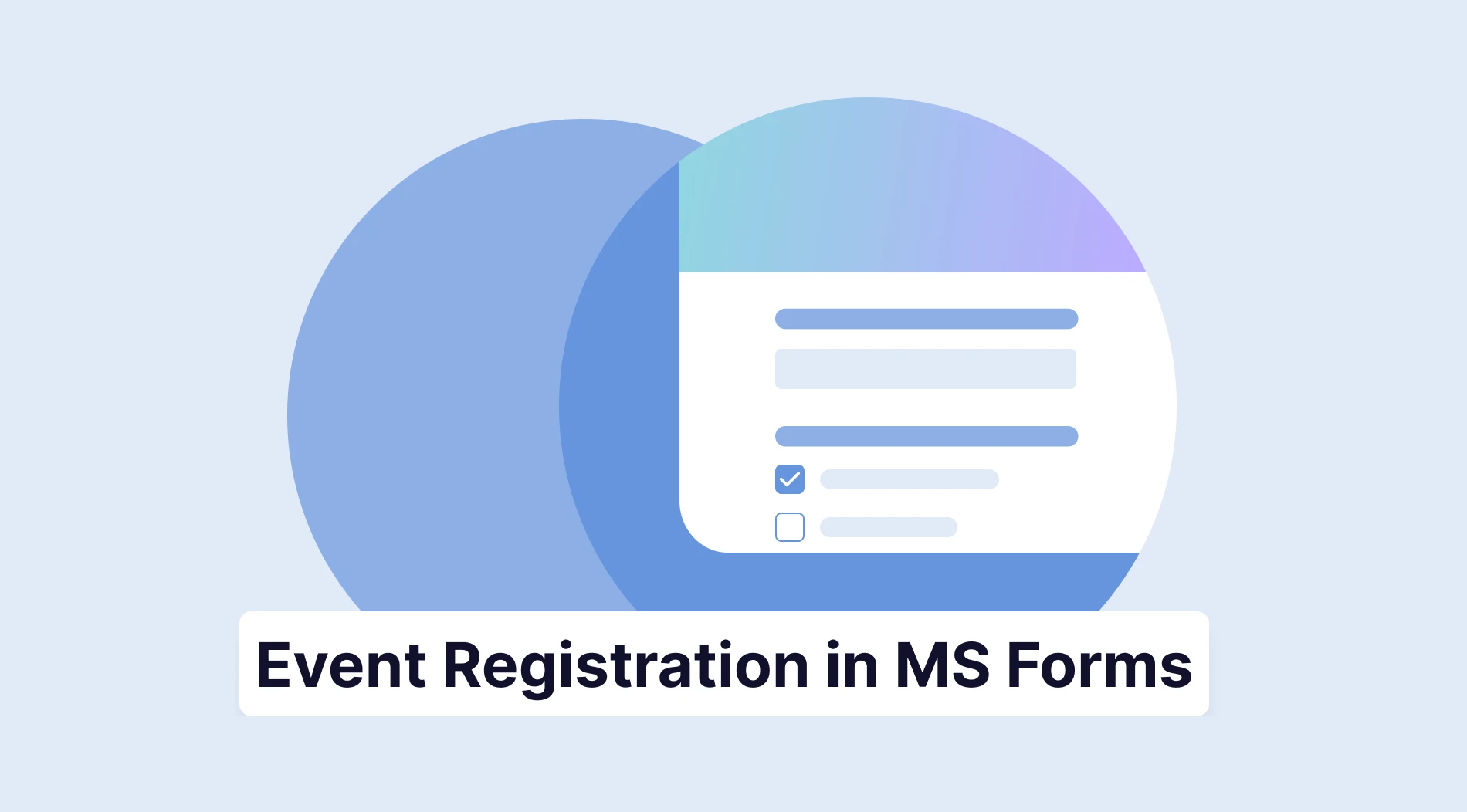Sampling techniques make researchers practical. There are several types of sampling methods, depending on your research group. You can use a process known as snowball sampling when researching populations of people that may be difficult to come into contact with.
The snowball sampling method is used by researchers when the sample for the study is scarce or only includes a tiny subset of the general population. Learning about this method can help you access these populations and successfully understand them to advance your research. This article will explain the snowball sampling definition and all detail about it.
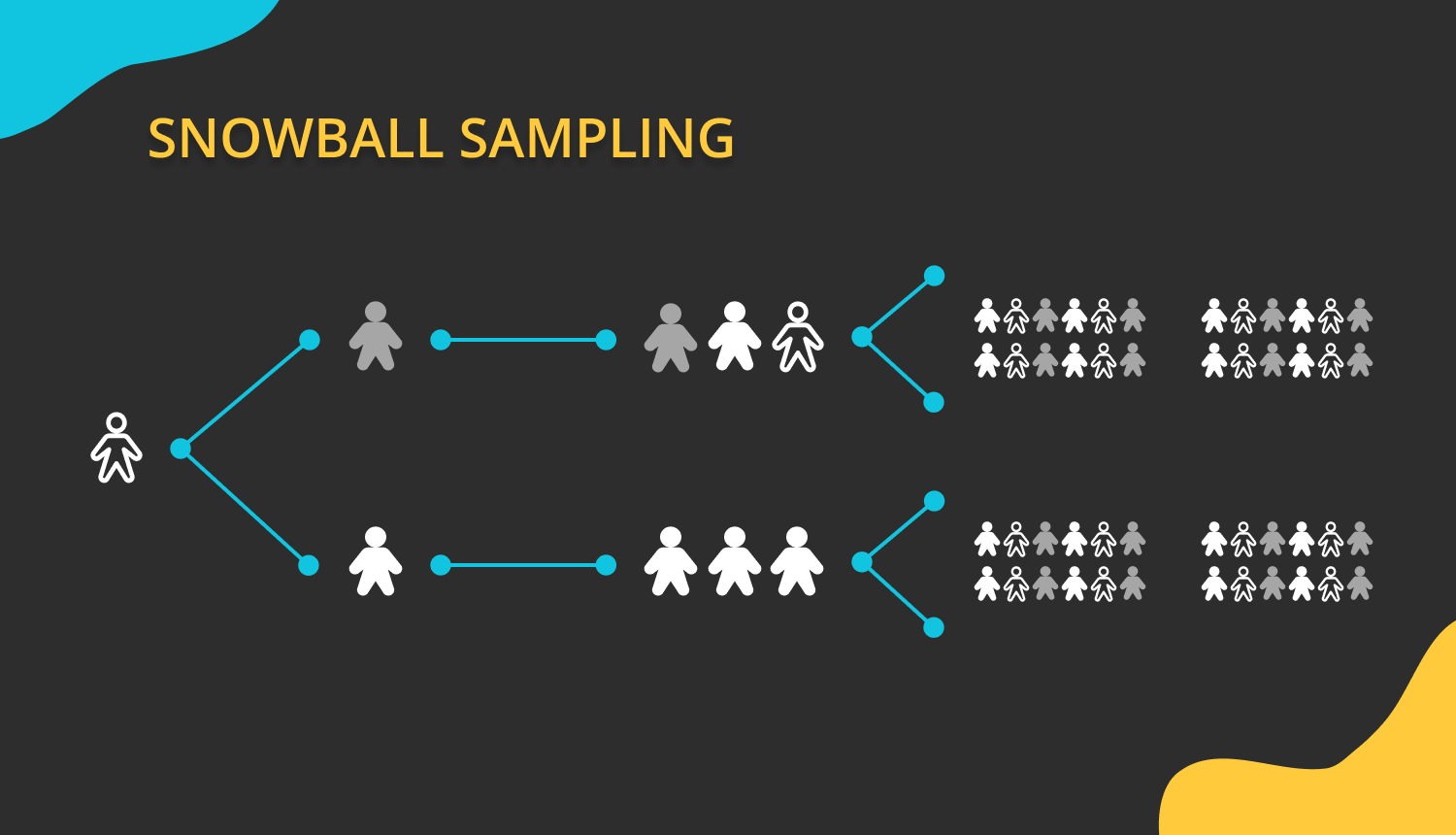
What is snowball sampling & why use it?
Snowball sampling, also defined as chain-referral sampling, is a non-probability sampling method where samples have unique characteristics. This sampling method uses subjects who are already available to help gather the samples needed for a study.
This method is similar to asking your subjects to suggest a different person who shares the same trait as your next subject. Once the researcher has a sufficient number of subjects, they observe the subjects who have been suggested and keep going in this manner.
It is common to use snowball sampling for business research. This sampling strategy can continue indefinitely, like a snowball growing in size, until a researcher has enough information to analyze and draw firm conclusions to help a business make informed decisions.
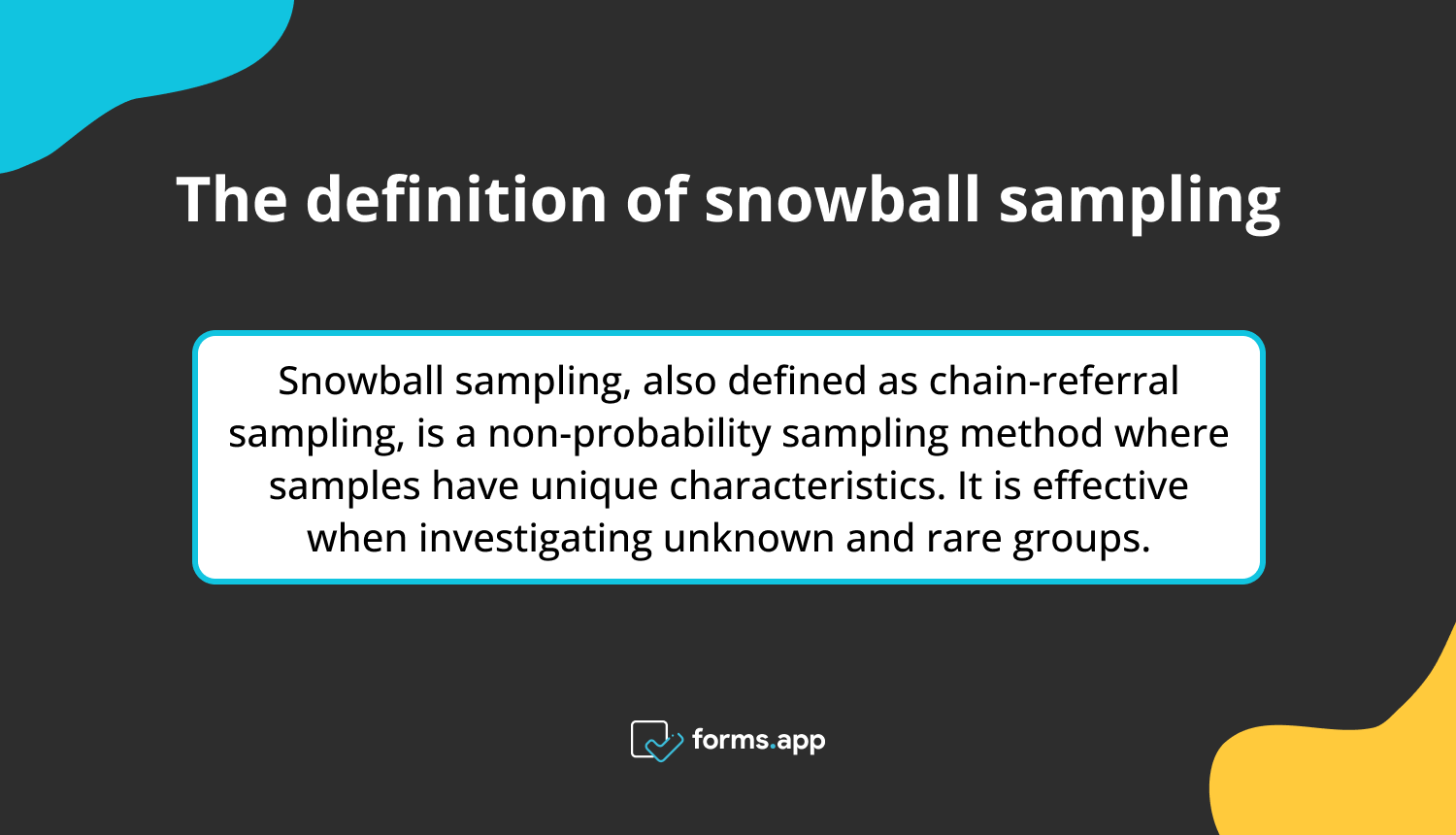
The definition of snowball sampling
Snowball sampling types
An initial convenience sample of one or more participants precedes snowball sampling. There are three varieties of the snowball sampling technique. The differences relate to the number of subjects each participant finds and the number of the study includes.
- Linear snowball sampling: One recruit is found in the first subject using linear snowball sampling. Then that subject seeks out another, and so forth. Researchers go through this process one at a time until they reach their desired number.
- Exponential non-discriminative snowball sampling: The first subject recruits numerous subjects using exponential non-discriminative snowball sampling. Each of these new subjects brings on several new participants. With this strategy, the sample can increase exponentially until it researches the desired size.
- Exponential discriminative snowball sampling: The exponential discriminative snowball is similar to the non-discriminative version because each participant identifies several additional potential recruits. The researchers, however, have more control over who participates because they choose just one referral from each subject. The study’s goal and objectives serve as a guide for their decision-making.
How to conduct a snowball sampling study
Many techniques adhere to a similar pattern, even though specific steps can change depending on your research topic or sampling strategy. To use snowball sampling in your study, consider the following steps:
1 - Select potential population participants: Identifying a sample subject is the first step in successfully using snowball sampling. One or two sources for your initial research may come from this step. To guarantee a representative sample, it's crucial to confirm that these potential participants meet the arbitrary requirements of your study.
2 - Contact potential participants: Once you have chosen your sample subjects, contact them to see if they'd be interested in participating in your study. Subjects can be reached in various ways, including by phone or email.
You can complete the remaining sampling steps if the subjects agree to participate. You can either contact your second sample source or look for alternative sources if they don’t want to participate in the study.
3 - Invite participants to participate in the study: Inform them about the research before asking them to participate. Participants who are unsure about participating can decide to do so with the help of this explanation. Inquire about subject referrals even if your subjects are unwilling to join in enlarging your sample.
4 - Promote subject suggestions: You can encourage them to suggest additional research subjects once the initial subjects are signed up for your study. Instead of asking participants to name other potential subjects, you might encourage them to suggest they contact you directly. This approach can be beneficial when researching delicate subjects because it gives referred subjects the option of getting you or not.
5 - Analyze the discriminative sampling: Analyze the referral data you receive using discriminative sampling techniques. This analysis guarantees that you can choose the research subjects that are most pertinent to it. This analysis can be used to find participants who meet the criteria for your topic's research objectives, such as participants who meet a particular age or criteria.
6 - Continue until you have the required samples: You can ask your initial referrals for additional information after speaking with them. Repeat these steps to contact all referrals or reach the target population. If you have determined that you have gathered a sizeable enough sample size, you may also stop recruiting participants.
Snowball sampling examples: How is snowball sampling used in different fields and contexts?
With the snowball method, a researcher can create a sample solely through recommendations. Snowball sampling is the only method for gathering data and essential information for some populations. The following situations call for the use of this sampling:
- Individuals who don't want their identities revealed: This is the case when a researcher is gathering information from subjects for a study that might be deemed sensitive, such as those who have experienced sexual assault or do not want to express their sexual orientation publicly.
- Hard-to-find people: Finding people with rare diseases can be challenging. Finding the primary data source can be difficult if a researcher is conducting a study that is similar to this one. After being identified, they frequently have information on additional people who look like them.
- No official roster of members: When there are no readily available data for a population, such as their demographics, this sampling technique can be used—for instance, research about homeless people.
Advantages and disadvantages of snowball sampling
Snowball sampling is an effective way of investigating unknown and rare groups. Snowball sampling has advantages and disadvantages, just like all other research techniques. It is crucial to be aware of these to decide if it is the best approach for your research design.
Advantages of snowball sampling:
- Cost-effective: Since sample referrals account for a large portion of the sourcing for snowball sampling, it is quicker to gather data population. Compared to other methods, it is affordable and convenient.
- Quick sample sourcing: Researchers spend less time looking for subjects when participants refer others. Using this sample sourcing, you can concentrate your time and effort on your research.
- Access to target populations: Since you receive referrals from your primary sources, snowball sampling enables you to access niche populations. With source referrals, finding or even contacting some groups can be more accessible.
- Minimum resource planning: You can perform minimal source planning when your subjects provide referrals. Many subjects might get in touch with you directly, or they might name other potential sources you could get in touch with.
Disadvantages of snowball sampling:
- The margin of error: If a sample bias is present, your data may have a margin of error. To reduce this margin, it's crucial to calculate and interpret the data correctly.
- Lack of cooperation: Some data populations might be reluctant to cooperate with research efforts. You can take action to ensure subjects' privacy in those circumstances, so they feel secure providing information for the study.
- Sample bias: Sample bias is possible given that sample subjects compare you to other population members. Ensuring your study's sample population represents the population's overall distribution will help you avoid bias.
When to use snowball sampling and when to avoid it
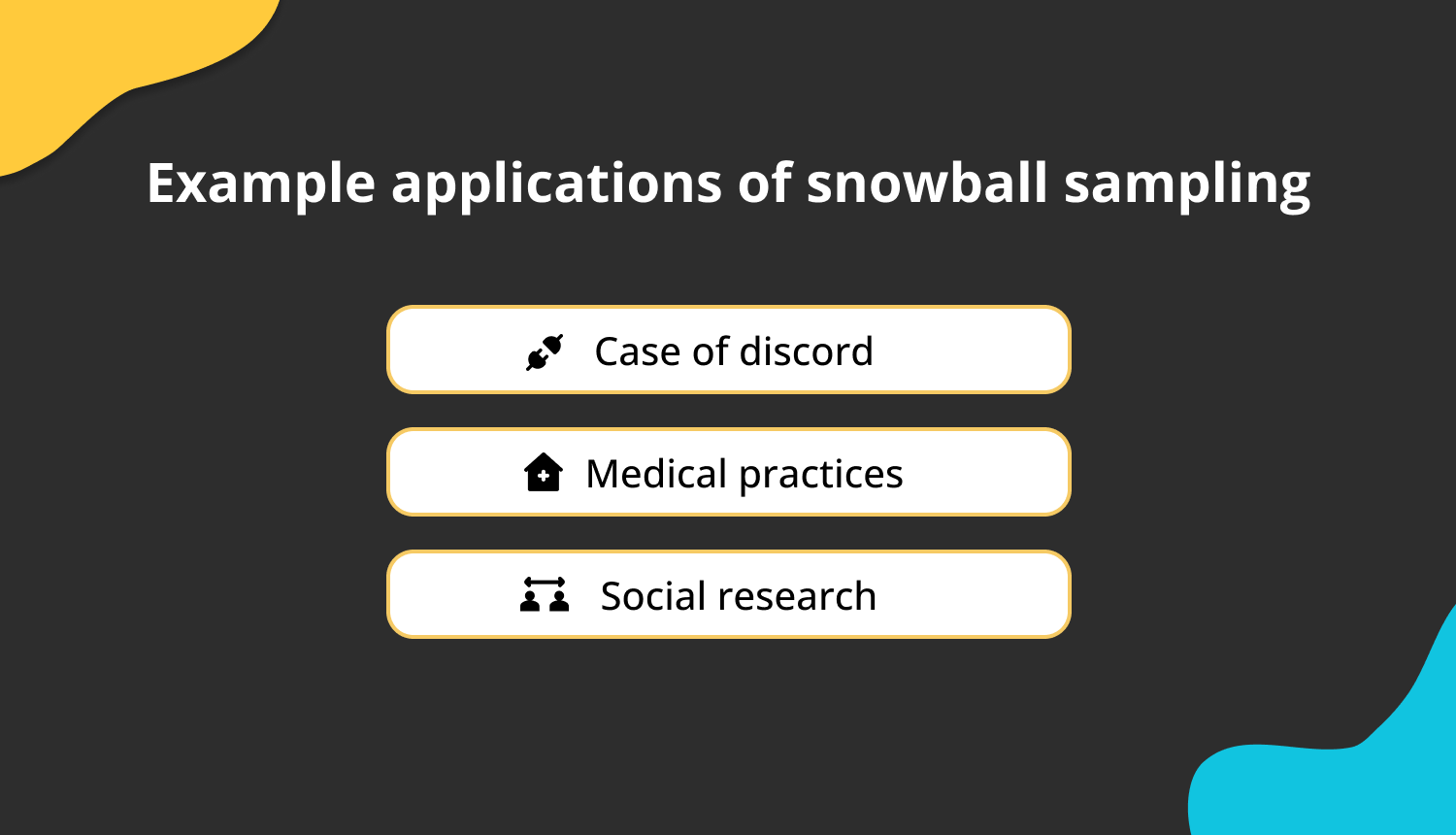
Snowball sampling is a widespread technique in qualitative research. This approach is typically used to research geographically dispersed populations, sensitive topics that people may prefer not to discuss in public, folks with a social stigma, or populations with specific characteristics of interest. In each of these scenarios, the availability of a sampling framework makes it challenging for non-members to access members of the people.
When the population of research participants is unknown or challenging, this sampling is practical. Your pool of potential research subjects can grow thanks to this research methodology. Although it can be used in a wide range of settings, the following kinds of research favor using snowball sampling:
- Case of discord: Researchers frequently use snowball sampling when looking into issues of discord or other touchy subjects. Investigators can use this technique to safeguard the privacy of topics, such as those who have witnessed an event.
- Medical practices: Many researchers in the medical field employ snowball sampling to reach out to individuals with uncommon or understudied diseases. They can use this research method to help create and comprehend those conditions.
- Social research: Researchers in this field use snowball sampling to assemble participants to gather as much data as possible about a population. Researchers frequently use this method when conducting social research in areas where participants may need to be more willing to contribute.
In contrast, researchers have little control over the sample because they do not choose the participants. As a result, scientists won't know much about how representative the sample is of the intended audience. Sampling bias is a fear of researchers when using this sampling technique, so you can avoid using this method in a specific research group.
How biased is snowball sampling?
The bias of snowball sampling is that it's difficult to tell whether you're studying moderates or the other end of the population. You should be made aware of where your behavior falls on the behavior continuum. However, bias does not necessarily render snowball examples wholly incorrect or undesirable. This means that researchers must be conscious of potential biases and ready to consider how they affect findings and conclusions.
Key takeaways and tips for snowball sampling
In conclusion, snowball sampling is a type where the pool of initially enrolled participants is used to find new study participants who meet the requirements. Snowball sampling is an example of nonprobability sampling in which participants are selected subjectively.
The process of enrolling participants can go on indefinitely with snowball sampling as long as the researcher is happy with the size of the study pool. It is advantageous to use when recruiting through other people is necessary because the needed participants are more masked in the population.
The snowball sampling technique is often used in social, medical, or business psychological studies. Snowball sampling bias is a consequence that must be considered when using it because it may affect the reliability of the results.
- What is snowball sampling & why use it?
- Snowball sampling types
- How to conduct a snowball sampling study
- Snowball sampling examples: How is snowball sampling used in different fields and contexts?
- Advantages and disadvantages of snowball sampling
- When to use snowball sampling and when to avoid it
- How biased is snowball sampling?
- Key takeaways and tips for snowball sampling
forms.app, your free form builder
- Unlimited views
- Unlimited questions
- Unlimited notifications


